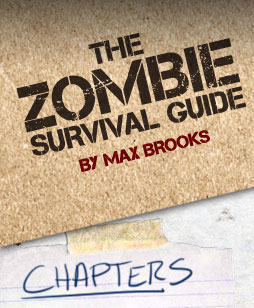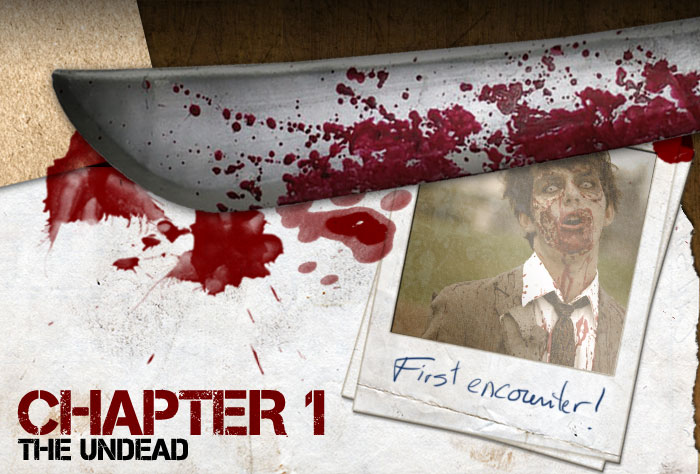


 |
 |
|---|---|
 |
|
What is a zombie? How are they created? What are their strengths and weaknesses? What are their needs, their desires? Why are they hostile to humanity? Before discussing any survival techniques, you must first learn what you are trying to survive. GO TO SECTION : Solanum : The Virus , Zombie Attributes , Outbreaks
Their origin stems from a virus known as Solanum, a Latin word used by Jan Vanderhaven, who first "discovered" the disease.
SYMPTOMS: The timetable below outlines the process of an infected human (give or take several hours, depending on the individual). Hour 1: Pain and discoloration (brown-purple) of the infected area Immediate clotting of the wound provided the infection came from a wound). Hour 5: Fever (99-103 degrees F), chills, slight dementia, vomiting, acute pain in the joints. Hour 8: Numbing of extremities and infected area, increased fever (103-106 degrees F), increased dementia, loss of muscular coordination. Hour 11: Paralysis in the lower body, overall numbness, slowed heart rate. Hour 16: Coma. Hour 20: Heart stoppage. Zero brain activity Hour 23: Reanimation. TRANSFERENCE: Solanum is 100 percent communicable and 100 percent fatal. Fortunately for the human race, the virus is neither waterborne nor airborne. Humans have never been known to contract the virus from elements in nature. Infection can occur only through direct fluidic contact. A zombie bite, although by far the most recognizable means of transference, is by no means the only one. Humans have been infected by brushing their open wounds against those of a zombie or by being splattered by its remains after an explosion. Ingestion of infected flesh (provided the person has no open mouth sores), however, results in pemanent death rather than infection. Infected flesh has proven to be highly toxic. CROSS-SPECIES INFECTION: Solanum is fatal to all living creatures, regardless of size, species, or ecosystem. Reanimation, however, takes place only in humans. TREATMENT: Once a human is infected, little can be done to save him or her. Because
Solanum is a virus and not a bacteria, antibiotics have no effect.
Immunization, the only way to combat a virus, is equally useless, as even
the most minute dosage will lead to a full-blown infection. PHYSICAL ABILITIES: Too often, the undead have been said to possess superhuman powers: unusual strength, lightning speed, telepathy, etc. Stories range from zombies flying through the air to their scaling vertical surfaces like spiders. While these traits might make for fascinating drama, the individual ghoul is far from a magical, omnipotent demon. Never forget that the body of the undead is, for all practical purposes, human. What changes do occur are in the way this new, reanimated body is used by the now-infected brain.
Sound: There is no question that zombies have excellent hearing. Not only can they detect sound-they can determine its direction. The basic range appears to be the same as that for humans. It has been recorded that ghouls will notice sounds ignored by living humans. The most likely, if unproven, explanation is that zombies depend on all their senses equally. Humans are sightoriented from birth, depending on other senses only if the primary one is lost. Perhaps this is not a handicap shared by the walking dead. If so, it would explain their ability to hunt, fight, and feed in total darkness. Smell: Unlike with sound, the undead have a more acute sense of smell. In both combat situations and laboratory tests, they have been able to distinguish the smell of living prey above all others. In many cases, and given ideal wind conditions, zombies have been known to smell fresh corpses from a distance of more than a mile. Taste: Little is known about the altered taste buds of the walking dead. Zombies do have the ability to tell human flesh apart from that of animals, and they prefer the former. Touch: Zombies have, literally, no physical sensations. All nerve receptors throughout the body remain dead after reanimation. This is truly their greatest and most terrifying advantage over the living. We, as humans, have the ability to experience physical pain as a signal of bodily damage.The inability to recognize and avoid pain is what makes the waking dead so formidable. Wounds will not be noticed and, therefore, will not deter an attack. Even if a zombie's body is severely damaged, it will continue to attack until nothing remains. Decomposition: The average zombie "life span"-how long it is able to function before completely rotting away-is estimated at three to five years. Digestion: Recent evidence has once and for all mscounted the theory that human flesh is the fuel for the undead. A zombie's digestive tract is completely dormant. The complex system that processes food, extracts nutrition, and excretes waste does not factor into a zombie's physiology. Autopsies conducted on neutralized undead have shown that their "food" lies in its original, undigested state at all sections of the tract. This partially chewed, slowly rotting matter will continue to accumulate, as the zombie devours more victims, until it is forced through the anus, or literally bursts through the stomach or intestinal lining. Strength: Ghouls possess the same brute force as the living. What power can be exerted depends greatly on the individual zombie. What muscle mass a person has in life would be all he possesses in death. Unlike a living body, adrenal glands have not been known to function in the dead, denying zombies the temporary burst of power we humans enjoy. The one solid advantage the living dead do possess is amazing stamina.They will continue an act, with the same dynamic energy, until the muscles supporting it literally disintegrate. Speed: The "walking" dead tend to move at a slouch or limp. Even without injuries or advanced decomposition, their lack of coordination makes for an unsteady guide. Speed is mainly determined by leg length. Taller ghouls have longer strides than their shorter counterparts. Zombies appear to be incapable of running. Agiliy: The average living human possesses a dexterity level 90 percent greater than the strongest ghoul. Some of this comes from the general stiffness of necrotic muscle tissue (hence their awkward stride). The rest is due to their primitive brain functions. Zombies have little handeye coordination, one of their greatest weaknesses.
Disposal: Studies have shown that Solanum can still
inhabit the body of a terminated zombie for
up to fortyeight hours. Exercise extreme
care when disposing of undead corpses. Although each zombie attack is different, given the number, terrain, reaction of the general populace, etc., its level of intensity can be measured in four distinct classes. CLASS 1: This is a low-level outbreak, usually in a Third World country or First World rural area. The number of zombies in this class of outbreak ranges between one and twenty. Total human casualties (including those infected) range from one to fifty. The total duration, from the fist case to the last (known), will range between twenty-four hours and fourteen days. CLASS 2: Urban or densely populated rural areas are included in this level of outbreak. Total zombies will range between twenty and one hundred. Total human casualties may reach as high as several hundred. The duration of a Class 2 attack may last no longer than a Class 1 outbreak.
CLASS 4: (See "Living in an Undead World") |